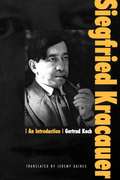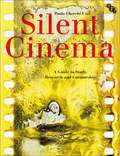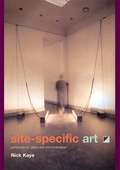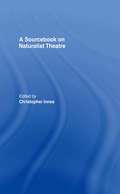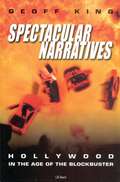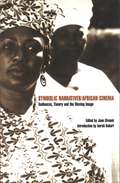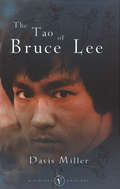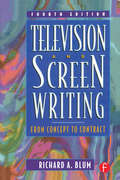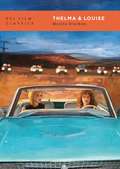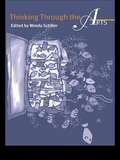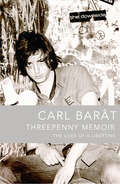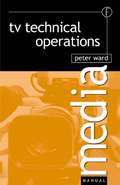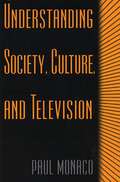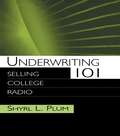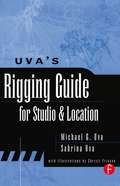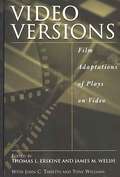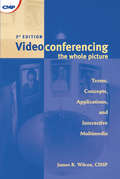- Table View
- List View
Siegfried Kracauer: An Introduction
by Gertrud Koch Jeremy GainesSiegfried Kracauer has been misunderstood as a naïve realist, appreciated as an astute critic of early German film, and noticed as the interesting exile who exchanged letters with Erwin Panofsky. But he is most widely thought of as the odd uncle of famed Frankfurt School critical theorists Jürgen Habermas, Theodor Adorno, Walter Benjamin, and Max Horkheimer. Recently, however, scholars have rediscovered in Kracauer's writings a philosopher, sociologist, and film theorist important beyond his associations--and perhaps one of the most significant cultural critics of the twentieth century. Gertrud Koch advances this Kracauer renaissance with the first-ever critical assessment of his entire body of work. Koch's analysis, which is concise without sacrificing thoroughness or sophistication, covers both Kracauer's best-known publications (e.g., From Caligari to Hitler, in which he gleans the roots of National Socialism in the films of the Weimar Republic) and previously underexamined texts, including two newly discovered autobiographical novels. Because Kracauer's wide-ranging works emerge from no rigidly unified approach, instead always remaining open to unusual and highly individual perspectives, Koch resists the temptation to force generalization. She does, however, identify recurring tropes in Kracauer's lifetime effort to perceive the basic posture and composition of particular cultures through their visual surfaces. Koch also finds in Kracauer a surprisingly contemporary cultural commentator, whose ideas speak directly to current discussions on film, urban modernity, feminism, cultural representation, violence, and other themes. This book was long-awaited in Germany, as well as widely and well reviewed. Now translated into English for the first time, it will fuel already growing interest in the United States, where Kracauer lived and wrote from 1941 until his death in 1966. It will attract the attention of students and scholars working in Film Studies, German Studies, Comparative Literature, Critical Theory, Cultural Studies, Philosophy, and History.
Silent Cinema: A Guide to Study, Research and Curatorship
by Paolo Cherchi UsaiPaolo Cherchi Usai provides a comprehensive introduction to the study, research and preservation of silent cinema from its heyday in the early 20th century to its present day flourishing. He traces the history of the moving image in its formative years, from Edison's and Lumière's first experiments to the dawn of 'talkies'; provides a clear guide to the basics of silent film technology; introduces the technical and creative roles involved in its production, and presents silent cinema as a performance event, rather than a passive viewing experience. This new, greatly expanded edition takes the reader on a new journey, exploring silent cinema in the broader context of technology, culture, and society, from the invention of celluloid film and its related machinery to film studios, laboratories, theatres and audiences. Among the people involved in the creation of a new art form were filmmakers, actors and writers, but also engineers, entrepreneurs, and projectionists. Their collective efforts, and the struggle to preserve their creative work by archives and museums, are interwoven in a compelling story covering three centuries of media history, from the magic lantern to the reinvention of silent cinema in digital form.The new edition also includes comprehensive resource information for the study, research, preservation and exhibition of silent cinema.
Site-Specific Art: Performance, Place and Documentation
by Nick KayeSite-Specific Art charts the development of an experimental art form in an experimental way. Nick Kaye traces the fascinating historical antecedents of today's installation and performance art, while also assembling a unique documentation of contemporary practice around the world. The book is divided into individual analyses of the themes of space, materials, site, and frames. These are interspersed by specially commissioned documentary artwork from some of the world's foremost practitioners and artists working today. This interweaving of critique and creativity has never been achieved on this scale before. Site-Specific Art investigates the relationship of architectural theory to an understanding of contemporary site related art and performance, and rigorously questions how such works can be documented. The artistic processes involved are demonstrated through entirely new primary articles from: * Meredith Monk * Station House Opera * Brith Gof * Forced Entertainment. This volume is an astonishing contribution to debates around experimental cross-arts practice.
Site-Specific Art: Performance, Place and Documentation
by Nick KayeSite-Specific Art charts the development of an experimental art form in an experimental way. Nick Kaye traces the fascinating historical antecedents of today's installation and performance art, while also assembling a unique documentation of contemporary practice around the world. The book is divided into individual analyses of the themes of space, materials, site, and frames. These are interspersed by specially commissioned documentary artwork from some of the world's foremost practitioners and artists working today. This interweaving of critique and creativity has never been achieved on this scale before. Site-Specific Art investigates the relationship of architectural theory to an understanding of contemporary site related art and performance, and rigorously questions how such works can be documented. The artistic processes involved are demonstrated through entirely new primary articles from: * Meredith Monk * Station House Opera * Brith Gof * Forced Entertainment. This volume is an astonishing contribution to debates around experimental cross-arts practice.
A Sourcebook on Naturalist Theatre
by Christopher InnesA Sourcebook on Naturalist Theatre provides essential primary sources which document one of the key movements in modern theatre. Christopher Innes has selected three writers to exemplify the movement, and six plays in particular: * Henrik Ibsen - A Dolls House and Hedda Gabler * Anton Chekhov - The Seagull and The Cherry Orchard * George Bernard Shaw - Mrs Warren's Profession and Heartbreak House. Innes' introduction provides an overview of naturalist theatre. Key themes include: the representation of women, significant contemporary issues and the links between theory, play writing and stage practice. The primary sources explore many aspects of naturalism, giving information on: * the playwrights' intentions when writing plays * contemporary reviews * literary criticism * political and social background * production notes from early performances of the plays.
A Sourcebook on Naturalist Theatre
by Christopher InnesA Sourcebook on Naturalist Theatre provides essential primary sources which document one of the key movements in modern theatre. Christopher Innes has selected three writers to exemplify the movement, and six plays in particular: * Henrik Ibsen - A Dolls House and Hedda Gabler * Anton Chekhov - The Seagull and The Cherry Orchard * George Bernard Shaw - Mrs Warren's Profession and Heartbreak House. Innes' introduction provides an overview of naturalist theatre. Key themes include: the representation of women, significant contemporary issues and the links between theory, play writing and stage practice. The primary sources explore many aspects of naturalism, giving information on: * the playwrights' intentions when writing plays * contemporary reviews * literary criticism * political and social background * production notes from early performances of the plays.
Spectacular Narratives: Hollywood in the Age of the Blockbuster (Cinema and Society)
by Geoff KingWhat is the appeal of the contemporary Hollywood blockbuster? The sheer scale and impact of big special effects sequences is part of the attraction of films such as Independence Day, Jurassic Park, Titanic or Mission Impossible. But they also offer other appeals, including the dynamics of narrative. Spectacular Narratives is the first serious book-length treatment of the contemporary blockbuster, including the digital-effects-based spectacle, space fictions, the action film, war spectaculars, the recent wave of disaster movies and films evoking new technologies such as virtual reality. Consideration is also given to the impact of profitable spin-offs such as film-related theme park rides and computer games.Geoff King argues against the view that an emphasis on the spectacular has led to an erosion of the importance of narrative in Hollywood. Instead, he suggests, even the most spectacular and effects-led contemporary blockbuster offers a blend of appeals, mixing elements of spectacle and narrative. Narrative is explored at the levels of both linear story-telling and underlying thematic patterns, a particular emphasis being placed on the persistence of elements of the myth/ideology of the American frontier. Close textual analysis is combined with consideration of the industrial and social contexts of contemporary Hollywood in a readable, original and rewarding book on the cinema that dominates markets across the globe.* discusses individual films as well as film-genres* shows how blockbusters are coming to dominate studio money as well as time* an overview of the way Hollywood seems to be forgetting how to tell stories
Star Trek: Parallel Narratives
by C. GregoryIn Star Trek Chris Gregory analyses the reasons for the continuing success of the Star Trek phenomenon, traces its overall development and comments on how the differences between 1990s and 1960s series reflect changes in the mass media environment during this period. He examines Star Trek as a series of generic and mythological texts, compares TV and filmed versions, explores its 'cult' appeal and looks in detail at its psychological, social and political themes.
Symbolic Narratives/African Cinema: Audiences, Theory and the Moving Image
by June GivanniIn the conference Africa and the History of Cinematic Ideas held in London in 1995, film-makers, cultural theorists and critics gathered to debate a range of issues. Views were exchanged on such topics as imperialism, and the problems of distribution.
The Tao Of Bruce Lee
by Davis MillerJust weeks after completing Enter the Dragon, his first vehicle for a worldwide audience, Bruce Lee - the self-proclaimed world's fittest man - died mysteriously at the age of thirty-two. The film has since grossed over $500 million, making it one of the most profitable in the history of cinema, and Lee has acquired almost mythic status.Lee's was a flawed, complex yet singular talent. He revolutionized the martial arts and forever changed action movie-making. As in The Tao of Muhammad Ali, Davis Miller brilliantly combines biography - the fullest, most unflinching and revelatory to date - with his own coming-of-age autobiography. The result is a unique and compelling book.
Television and Screen Writing: From Concept to Contract
by Richard A BlumNow in its fourth edition, Television and Screen Writing: From Concept to Contract is a classic resource for students and professionals in screenwriting and television writing. This book will teach you how to become a creative and marketable writer in every professional arena - including major studios, production companies, networks, cable and pay TV, animation, and interactive programs. Specific techniques and script samples for writing high-quality and producible "spec" scripts for theatrical motion pictures, the sitcom series, one-hour dramatic series, longform television, soaps, talk show, variety, animation, interactive and new media are provided. Television and Screen Writing: From Concept to Contract, Fourth Edition also offers a fully detailed examination of the current marketplace, and distinct strategies for marketing your scripts, from registering and copyrighting the script to signing with an agent. This new edition has been expanded to include the most up-to-date creative and professional script samples, marketing resources, and practical information possible. The companion website (www.focalpress.com/companions) offers a wide range of contacts and resources for you to explore, and Internet links to professional resources. There is also an Annotated and Selected Bibliography for your reference
Television and Screen Writing: From Concept to Contract
by Richard A BlumNow in its fourth edition, Television and Screen Writing: From Concept to Contract is a classic resource for students and professionals in screenwriting and television writing. This book will teach you how to become a creative and marketable writer in every professional arena - including major studios, production companies, networks, cable and pay TV, animation, and interactive programs. Specific techniques and script samples for writing high-quality and producible "spec" scripts for theatrical motion pictures, the sitcom series, one-hour dramatic series, longform television, soaps, talk show, variety, animation, interactive and new media are provided. Television and Screen Writing: From Concept to Contract, Fourth Edition also offers a fully detailed examination of the current marketplace, and distinct strategies for marketing your scripts, from registering and copyrighting the script to signing with an agent. This new edition has been expanded to include the most up-to-date creative and professional script samples, marketing resources, and practical information possible. The companion website (www.focalpress.com/companions) offers a wide range of contacts and resources for you to explore, and Internet links to professional resources. There is also an Annotated and Selected Bibliography for your reference
Thelma & Louise (BFI Film Classics)
by Marita SturkenThelma & Louise, directed by Ridley Scott and written by Callie Khouri, sparked a remarkable public discussion about feminism, violence, and the representation of women in cinema on its release in 1991. Subject to media vilification for its apparent justification of armed robbery and manslaughter, it was a huge hit with audiences composed largely but not exclusively of women who cheered the fugitive central characters played by Susan Sarandon and Geena Davis. Marita Sturken examines Thelma & Louise as one of those rare films that encapsulates the politics of its time. She discusses the film's reworking of the outlaw genre, its reversal of gender roles, and its engagement with the complex relationship of women, guns adn the law. The insights of director Scott, screenwriter Khouri as well as Davis and Sarandon are deployed in an analysis of Thelma & Louise and the controversies it sparked. This is a compelling study of a landmark in 1990s American cinema.In her foreword to this new edition, Sturken looks back on the film's reception at the time of its release, and considers its continuing resonances and topicality in the age of #MeToo.
Thinking Through the Arts
by Wendy SchillerThinking Through the Arts draws together a number of different approaches to teaching young children that combine the experience of thinking with the act of expression through art. Developed as an inclusive, broad-ranging and user-friendly text, Thinking Through the Arts presents the unique insight of teachers as researchers, and counters the view that art is emotionally-based and therefore irrelevant to thinking and learning. The areas covered include drama, dance, music, arts environments, technologies, museums and galleries, literacy, cognition, international influences, curriculum development, research and practice. Early childhood and primary teachers and students alike will find this book is an invaluable source of new insights for their own teaching.
Thinking Through the Arts
by Wendy SchillerThinking Through the Arts draws together a number of different approaches to teaching young children that combine the experience of thinking with the act of expression through art. Developed as an inclusive, broad-ranging and user-friendly text, Thinking Through the Arts presents the unique insight of teachers as researchers, and counters the view that art is emotionally-based and therefore irrelevant to thinking and learning. The areas covered include drama, dance, music, arts environments, technologies, museums and galleries, literacy, cognition, international influences, curriculum development, research and practice. Early childhood and primary teachers and students alike will find this book is an invaluable source of new insights for their own teaching.
Threepenny Memoir: The Lives Of A Libertine
by Carl BaratThe extraordinary life and times of Carl Barat, Libertine.
TV Technical Operations: An introduction (Media Manuals Ser.)
by Peter WardTV Technical Operations is an introduction for new entrants to the broadcast industry and is designed to prepare them for working in mainstream television by discussing essential techniques, technologies and work attitudes. The author explores:* the need to develop a professional approach* the occupational skills needed to meet deadlines, work under pressure and within budget* the importance of understanding the potential of broadcast equipment in program making* the need to keep up to date with the technique and technology* the responsibility to ensure continuity of experience and training in all craft skills that technical operators are required to work with* the need to maintain a critical appraisal of what and who influences working practices and how these influences affect production and viewers* an introduction to the basic skills needed to work as a multi-skilling technical operator in television* an introduction to broadcast equipment in general production usePeter Ward is a freelance cameraman and camerawork trainer working with international training and television consultancy. He was formerly head of cameras at Television South West.
TV Technical Operations: An introduction
by Peter WardTV Technical Operations is an introduction for new entrants to the broadcast industry and is designed to prepare them for working in mainstream television by discussing essential techniques, technologies and work attitudes. The author explores:* the need to develop a professional approach* the occupational skills needed to meet deadlines, work under pressure and within budget* the importance of understanding the potential of broadcast equipment in program making* the need to keep up to date with the technique and technology* the responsibility to ensure continuity of experience and training in all craft skills that technical operators are required to work with* the need to maintain a critical appraisal of what and who influences working practices and how these influences affect production and viewers* an introduction to the basic skills needed to work as a multi-skilling technical operator in television* an introduction to broadcast equipment in general production usePeter Ward is a freelance cameraman and camerawork trainer working with international training and television consultancy. He was formerly head of cameras at Television South West.
Understanding Society, Culture, and Television (Non-ser.)
by Paul MonacoWhat is the real nature of television, and what is its place in contemporary society and culture? In a provocative rethinking of the medium and its ensuing effects, this book argues that we have misunderstood television and have thus contributed to a distorted view of art and culture in the 20th century. During the final quarter of this century both in academic and popular circles, we have spread wildly exaggerated claims about television's undermining of human consciousness and behavior. Television has become a scapegoat for all sorts of societal and cultural ills. The arguments presented by many researchers on behalf of the ill-effects of TV are fundamentally weak and flawed. On the eve of the 21st century, the claimed distinctions between high art and popular culture have become a final, hopeless repository of pedantry. Television can be understood only by viewing it as an art form, and measuring its role in society and culture in concert with the first principles of human reason and liberty.
Underwriting 101: Selling College Radio
by Shyrl L. PlumThis media sales primer serves as a step-by-step manual to assist students in attaining sales proficiency and confidence. The author employs a practical, hands-on approach, enabling readers to develop valuable professional and interpersonal skills and to improve their options for obtaining sales positions. Underwriting 101 covers the activities involved in sales work, such as developing sales kits and presentations, handling objections, writing proposals, closing, and preparing underwriting announcements. Role-playing, sales promotion, résumé preparation, and interviewing are also covered. Special features include: *materials needed to teach the 15 week course, including a syllabus, calls schedule, positioning worksheet, sample proposals, sample résumé, sample cover letter, and course evaluation; *comments from former students who have secured sales positions upon completion of the course; *underwriting announcement guidelines for FCC conformation; and *a guide to Internet research tools for sales presentation enhancement. Intended for upper-level students in radio or broadcast sales courses, Underwriting 101 will be useful to sales instructors with or without sales experience. It is also appropriate for use in college radio stations, as a resource for sales departments.
Underwriting 101: Selling College Radio
by Shyrl L. PlumThis media sales primer serves as a step-by-step manual to assist students in attaining sales proficiency and confidence. The author employs a practical, hands-on approach, enabling readers to develop valuable professional and interpersonal skills and to improve their options for obtaining sales positions. Underwriting 101 covers the activities involved in sales work, such as developing sales kits and presentations, handling objections, writing proposals, closing, and preparing underwriting announcements. Role-playing, sales promotion, résumé preparation, and interviewing are also covered. Special features include: *materials needed to teach the 15 week course, including a syllabus, calls schedule, positioning worksheet, sample proposals, sample résumé, sample cover letter, and course evaluation; *comments from former students who have secured sales positions upon completion of the course; *underwriting announcement guidelines for FCC conformation; and *a guide to Internet research tools for sales presentation enhancement. Intended for upper-level students in radio or broadcast sales courses, Underwriting 101 will be useful to sales instructors with or without sales experience. It is also appropriate for use in college radio stations, as a resource for sales departments.
Uva's Rigging Guide for Studio and Location
by Michael Uva Sabrina UvaReaders of Mike Uva's GRIP BOOK who are interested in more detailed information on the work of the grip department will welcome his new rigging manual, clearly detailing all the ways to mount cameras and lights both on a set as well as on location. The book covers the latest truss systems, rigging equipment and portable stages, as well as lifts, boom arms and camera mounts for every type of moving vehicle. The book is not limited to equipment specifications, however; Uva offers tips and tricks throughout in order to make the process of setting up and shooting safer and more efficient. Grips often need to invent makeshift solutions in a short time, and Uva shares many such devices developed over his years in the film and TV industry. This book will help grips and key grips move on to the bigger feature projects and commercials that require this equipment. It will also be useful for directors of photography and producers in pre-planning the required equipment for specific shots.
Uva's Rigging Guide for Studio and Location
by Michael Uva Sabrina UvaReaders of Mike Uva's GRIP BOOK who are interested in more detailed information on the work of the grip department will welcome his new rigging manual, clearly detailing all the ways to mount cameras and lights both on a set as well as on location. The book covers the latest truss systems, rigging equipment and portable stages, as well as lifts, boom arms and camera mounts for every type of moving vehicle. The book is not limited to equipment specifications, however; Uva offers tips and tricks throughout in order to make the process of setting up and shooting safer and more efficient. Grips often need to invent makeshift solutions in a short time, and Uva shares many such devices developed over his years in the film and TV industry. This book will help grips and key grips move on to the bigger feature projects and commercials that require this equipment. It will also be useful for directors of photography and producers in pre-planning the required equipment for specific shots.
Video Versions: Film Adaptations of Plays on Video (Non-ser.)
by Thomas L. Erskine James M. WelshMany of our favorite films began as plays—some as well known as Shakespeare's Romeo and Juliet, and some not so well known as You've Got Mail's origin, a 1937 play Parfumerie by Miklos Laszlo. Video Versions identifies nearly 300 films and their theatrical origins, providing readers with an overview of the films and highlighting similarities and differences to the source plays. Perfect for teachers, students, and anyone interested in theater and film, it is the most complete resource available for video versions of plays.Each entry provides: the original play's title, author, and year of publication; the name of the film, year of production, director and adapter; the main cast and the characters they play; running time and rating if available. Following a plot summary, a critical analysis provides the similarities and differences of the play and film, including character and plot changes, setting, missing or added scenes, special film techniques, and behind-the-scenes information such as who turned down or lost particular parts when the play was adapted to film. A short list of sources for further reading follows each entry. Information about contacting distributors—for obtaining the films—is included in the introduction and an extensive index completes the volume.
Videoconferencing: The Whole Picture
by James R. WilcoxFirst published in 2000. Routledge is an imprint of Taylor & Francis, an informa company.
